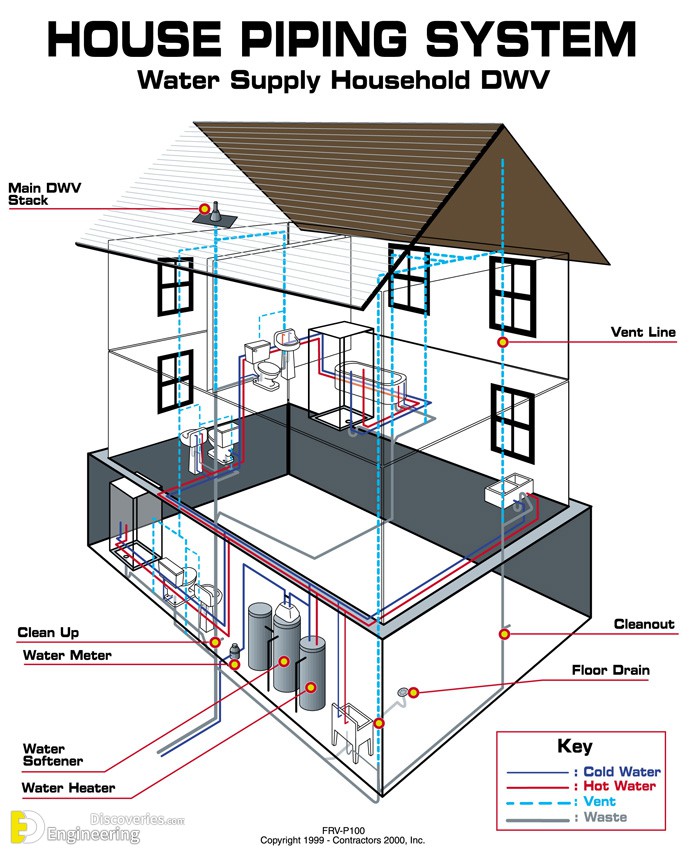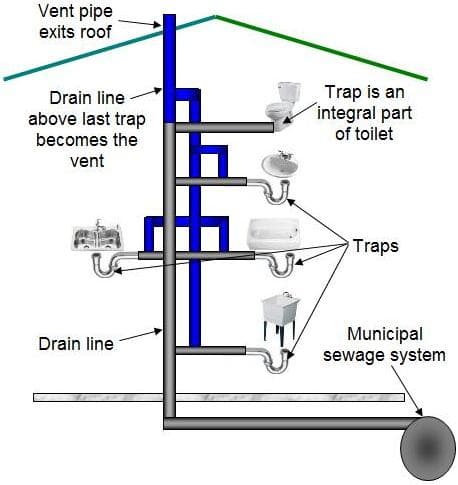We've noticed this article pertaining to Anatomy of a House: Understanding the Components directly below on the internet and accepted it made sense to share it with you in this article.

Comprehending exactly how your home's plumbing system works is important for every home owner. From delivering tidy water for alcohol consumption, cooking, and showering to safely getting rid of wastewater, a well-maintained pipes system is critical for your family members's wellness and convenience. In this thorough overview, we'll discover the elaborate network that composes your home's pipes and offer tips on upkeep, upgrades, and managing typical issues.
Introduction
Your home's pipes system is greater than just a network of pipes; it's a complex system that ensures you have accessibility to clean water and efficient wastewater elimination. Understanding its parts and just how they collaborate can help you prevent pricey repair services and guarantee whatever runs smoothly.
Standard Parts of a Plumbing System
Pipelines and Tubing
At the heart of your plumbing system are the pipes and tubes that bring water throughout your home. These can be made of numerous materials such as copper, PVC, or PEX, each with its benefits in regards to longevity and cost-effectiveness.
Components: Sinks, Toilets, Showers, etc.
Components like sinks, toilets, showers, and bath tubs are where water is utilized in your home. Understanding exactly how these fixtures link to the plumbing system aids in diagnosing problems and preparing upgrades.
Valves and Shut-off Factors
Valves manage the flow of water in your pipes system. Shut-off valves are critical during emergency situations or when you need to make fixings, enabling you to separate parts of the system without interfering with water flow to the entire residence.
Water System System
Key Water Line
The primary water line attaches your home to the local water supply or a personal well. It's where water enters your home and is distributed to different components.
Water Meter and Pressure Regulatory Authority
The water meter measures your water use, while a stress regulator makes sure that water moves at a safe stress throughout your home's plumbing system, stopping damages to pipelines and fixtures.
Cold Water vs. Hot Water Lines
Recognizing the distinction in between cold water lines, which provide water directly from the primary, and warm water lines, which lug heated water from the water heater, helps in fixing and preparing for upgrades.
Drain System
Drain Pipes Pipeline and Traps
Drain pipes bring wastewater far from sinks, showers, and bathrooms to the drain or septic tank. Traps stop drain gases from entering your home and additionally catch particles that can trigger blockages.
Air flow Pipes
Ventilation pipes allow air into the drain system, preventing suction that could slow down water drainage and create catches to empty. Appropriate air flow is crucial for maintaining the integrity of your plumbing system.
Significance of Correct Water Drainage
Ensuring proper drainage prevents backups and water damage. On a regular basis cleansing drains pipes and keeping catches can stop pricey fixings and extend the life of your plumbing system.
Water Heating System
Types of Hot Water Heater
Hot water heater can be tankless or standard tank-style. Tankless heating systems warm water on demand, while tanks keep heated water for immediate use.
How Water Heaters Connect to the Pipes System
Recognizing just how hot water heater link to both the cold water supply and hot water distribution lines helps in diagnosing concerns like not enough hot water or leaks.
Upkeep Tips for Water Heaters
Routinely flushing your hot water heater to eliminate sediment, checking the temperature level settings, and examining for leakages can prolong its lifespan and boost energy efficiency.
Common Pipes Problems
Leaks and Their Reasons
Leaks can occur as a result of maturing pipes, loose installations, or high water pressure. Addressing leakages quickly avoids water damages and mold and mildew growth.
Clogs and Clogs
Blockages in drains and commodes are usually brought on by purging non-flushable items or a build-up of grease and hair. Making use of drainpipe displays and being mindful of what decreases your drains can protect against blockages.
Indicators of Pipes Problems to Look For
Low water pressure, slow-moving drains, foul odors, or abnormally high water costs are indications of possible plumbing troubles that should be resolved quickly.
Plumbing Maintenance Tips
Normal Evaluations and Checks
Set up yearly plumbing inspections to catch issues early. Seek indicators of leaks, corrosion, or mineral buildup in taps and showerheads.
DIY Upkeep Tasks
Easy jobs like cleaning tap aerators, looking for toilet leaks making use of dye tablets, or shielding exposed pipelines in cool climates can stop significant plumbing issues.
When to Call an Expert Plumbing
Know when a pipes concern requires expert experience. Attempting complicated repair services without proper understanding can bring about even more damage and higher repair work expenses.
Updating Your Plumbing System
Reasons for Upgrading
Upgrading to water-efficient components or changing old pipelines can improve water high quality, minimize water costs, and raise the worth of your home.
Modern Plumbing Technologies and Their Benefits
Check out innovations like clever leakage detectors, water-saving commodes, and energy-efficient hot water heater that can conserve cash and decrease environmental impact.
Expense Considerations and ROI
Determine the in advance expenses versus long-lasting financial savings when thinking about pipes upgrades. Many upgrades spend for themselves with decreased energy costs and fewer repair services.
Ecological Impact and Conservation
Water-Saving Fixtures and Appliances
Setting up low-flow faucets, showerheads, and commodes can considerably lower water use without compromising performance.
Tips for Minimizing Water Use
Simple practices like fixing leaks immediately, taking shorter showers, and running full tons of washing and dishes can save water and lower your energy bills.
Eco-Friendly Pipes Options
Take into consideration sustainable plumbing products like bamboo for flooring, which is durable and green, or recycled glass for counter tops.
Emergency situation Preparedness
Actions to Take Throughout a Plumbing Emergency situation
Know where your shut-off shutoffs are located and how to shut off the water in case of a ruptured pipeline or major leak.
Importance of Having Emergency Contacts Convenient
Keep get in touch with info for neighborhood plumbing technicians or emergency solutions easily available for quick reaction throughout a pipes situation.
DIY Emergency Fixes (When Appropriate).
Momentary repairs like utilizing duct tape to spot a dripping pipe or positioning a container under a dripping tap can minimize damages until a specialist plumbing professional shows up.
Conclusion.
Recognizing the makeup of your home's plumbing system empowers you to keep it efficiently, conserving time and money on fixings. By adhering to routine upkeep routines and remaining informed concerning modern pipes modern technologies, you can ensure your pipes system operates successfully for years ahead.
HOW YOUR PLUMBING SYSTEM WORKS
Which Pipes Do What?
Blue lines = fresh water supply entering the building
Red lines = hot water supply entering the building
Grey lines = pipes carrying waste away from the building and venting pipes carrying gases away from the building (through the roof)
YOUR MAIN PLUMBING SYSTEMS
There are two main plumbing systems that support your home s basic plumbing needs one that brings clean water into your home, and one that sends dirty water away from your home. Connected to the toilet, bath, shower, and other faucets in your home, these two systems keep your water flowing in the right directions.
ACCESSING FRESH WATER
Fresh and clean water is brought into your home through the main water supply line . Filtered through one pipe, this water is pressured to flow into the various fixtures in your home at any given time.
This water can be sourced from a well located on your property, a pond or river (mostly cottages), or, as in most cases, from the city s municipal water treatment centre. However, it is important to note that water that is untreated, such as the water siphoned from ponds or rivers, may not be safe to drink. Personal water supplies always need to be treated for hardness and contaminants before consumed.
MUNICIPAL WATER SUPPLIES
Improve taste and odour
Remove sediment
Eliminate hardness
Reduce chlorine
COLD WATER SUPPLY VS. HOT WATER SUPPLY
Cold water flows into your home or building through the service line, which then distributes hot or cold water to your fixtures. This line is most commonly run through a central column that runs floor to floor. Hot water runs in short and straight pipes as the longer the pipeline, the more heat that will be lost in the transfer. Having shorter pipes also allows residents to access hot water more quickly.
WASTE WATER SYSTEM
Your wastewater system is divided into two parts pipes that send wastewater away from your home and venting pipes that send sewer gas away from your home. Sewage water travels through pipes that flush the water and waste towards local sewers that are operated and managed by your city or town. Most sewer systems rely on gravity to move the wastewater to where it needs to go.
The further away from your toilet or sink, the larger wastewater pipes become. This allows for waste to be disposed of from various parts of your home or business at once without pipe blockages. The angle and flow of these pipes are also essential for keeping your waste pipes clear of build up.
https://harrisplumbing.ca/how-your-home-plumbing-system-works/

HOW YOUR PLUMBING SYSTEM WORKS
Which Pipes Do What?
YOUR MAIN PLUMBING SYSTEMS
There are two main plumbing systems that support your home s basic plumbing needs one that brings clean water into your home, and one that sends dirty water away from your home. Connected to the toilet, bath, shower, and other faucets in your home, these two systems keep your water flowing in the right directions.
ACCESSING FRESH WATER
Fresh and clean water is brought into your home through the main water supply line . Filtered through one pipe, this water is pressured to flow into the various fixtures in your home at any given time.
This water can be sourced from a well located on your property, a pond or river (mostly cottages), or, as in most cases, from the city s municipal water treatment centre. However, it is important to note that water that is untreated, such as the water siphoned from ponds or rivers, may not be safe to drink. Personal water supplies always need to be treated for hardness and contaminants before consumed.
MUNICIPAL WATER SUPPLIES
COLD WATER SUPPLY VS. HOT WATER SUPPLY
Cold water flows into your home or building through the service line, which then distributes hot or cold water to your fixtures. This line is most commonly run through a central column that runs floor to floor. Hot water runs in short and straight pipes as the longer the pipeline, the more heat that will be lost in the transfer. Having shorter pipes also allows residents to access hot water more quickly.
WASTE WATER SYSTEM
Your wastewater system is divided into two parts pipes that send wastewater away from your home and venting pipes that send sewer gas away from your home. Sewage water travels through pipes that flush the water and waste towards local sewers that are operated and managed by your city or town. Most sewer systems rely on gravity to move the wastewater to where it needs to go.
The further away from your toilet or sink, the larger wastewater pipes become. This allows for waste to be disposed of from various parts of your home or business at once without pipe blockages. The angle and flow of these pipes are also essential for keeping your waste pipes clear of build up.
https://harrisplumbing.ca/how-your-home-plumbing-system-works/
I'm certainly very focused on Exploring Your Homes Plumbing Anatomy and I hope you enjoyed reading the blog post. Sharing is caring. Helping others is fun. I appreciate reading our article about Anatomy of a House: Understanding the Components.
Quote & Schedule